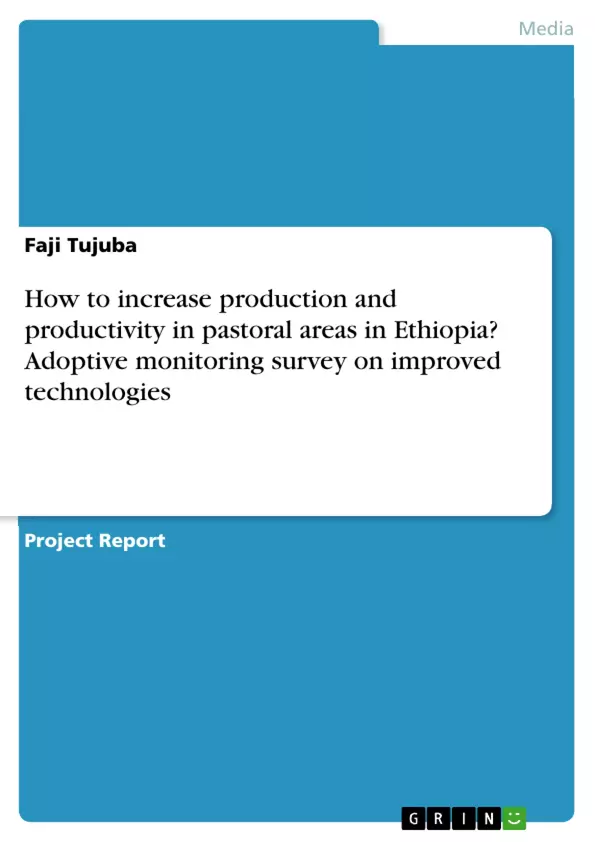Ethiopia is known for its climate extremes such as droughts, increasing temperature, and decreasing precipitation trends. Particularly the livelihoods of households in the pastoral areas have been suffering due to the increasing risk of climate extremes. Despite the complexity and high environmental stress, there are significant economic opportunities in the pastoral and agro-pastoral areas.
To overcome these challenges, the Pastoral Community Development Project (PCDP) has promoted a demand driven approach to enhance the production and productivity of the pastoral and agro-pastoral community. Based on this approach various improved technologies were demonstrated in selected kebelles on the pastoral fields.
The community driven development approach, based on the research of the Pastoral Research Group, is an important approach to address the gaps concerning the access of technology in the pastoral and agro-pastoral areas in Ethiopia.
Inhaltsverzeichnis (Table of Contents)
- Executive Summary
- Introduction
- Significance of the study
- Objective
- Methodology
- Result and Discussion
- Procedures undertaken during the implementation of PRG
- Result analysis and Discussion
- Lesson learned from the Adoptive Research and Innovative practice
- Conclusion and Recommendations
Zielsetzung und Themenschwerpunkte (Objectives and Key Themes)
This report evaluates the effectiveness of the Pastoral Community Development Project (PCDP-III) in promoting the adoption of improved agricultural technologies in pastoral and agro-pastoral regions of Ethiopia. The project utilized a participatory research approach, establishing Pastoral Research Groups (PRGs) to identify and address the needs of pastoral communities.
- Adoption of improved agricultural technologies in pastoral and agro-pastoral regions
- The effectiveness of the PCDP-III's participatory research approach
- The role of PRGs in facilitating technology adoption
- The impact of improved technologies on pastoral livelihoods
- Lessons learned from the implementation of the project
Zusammenfassung der Kapitel (Chapter Summaries)
- Executive Summary: Highlights the challenges faced by pastoral communities in Ethiopia due to climate extremes and limited access to improved technologies. Explains the PCDP-III's approach of establishing PRGs to address these challenges and summarizes the findings of the adoption monitoring survey.
- Introduction: Provides background information about the challenges faced by pastoral communities in Ethiopia, particularly concerning climate extremes and the need for demand-driven improved technologies. Introduces the PCDP-III project and its participatory research approach using PRGs.
- Significance of the study: Explains the importance of understanding the effectiveness of the PCDP-III project in promoting technology adoption and its contribution to improving the livelihoods of pastoral communities.
- Objective: Outlines the specific goals of the study, focusing on assessing the adoption of improved technologies in the targeted areas and analyzing the factors influencing technology adoption.
- Methodology: Describes the methods employed in the adoption monitoring survey, including the selection of project woredas and kebelles, sample size, and data collection techniques.
- Result and Discussion: Presents the findings of the survey, analyzing the adoption rates of different improved technologies by PRG and non-PRG members. Discusses the factors influencing technology adoption and the effectiveness of the PRG approach.
- Lesson learned from the Adoptive Research and Innovative practice: Draws lessons from the project implementation experience, identifying the strengths and weaknesses of the PRG approach and suggesting areas for improvement.
Schlüsselwörter (Keywords)
Key terms and concepts include pastoralism, agro-pastoralism, Ethiopia, technology adoption, participatory research, Pastoral Research Groups (PRGs), PCDP-III, improved agricultural technologies, climate change, livelihoods, and community-driven development.
- Citar trabajo
- Faji Tujuba (Autor), 2019, How to increase production and productivity in pastoral areas in Ethiopia? Adoptive monitoring survey on improved technologies, Múnich, GRIN Verlag, https://www.grin.com/document/477471



